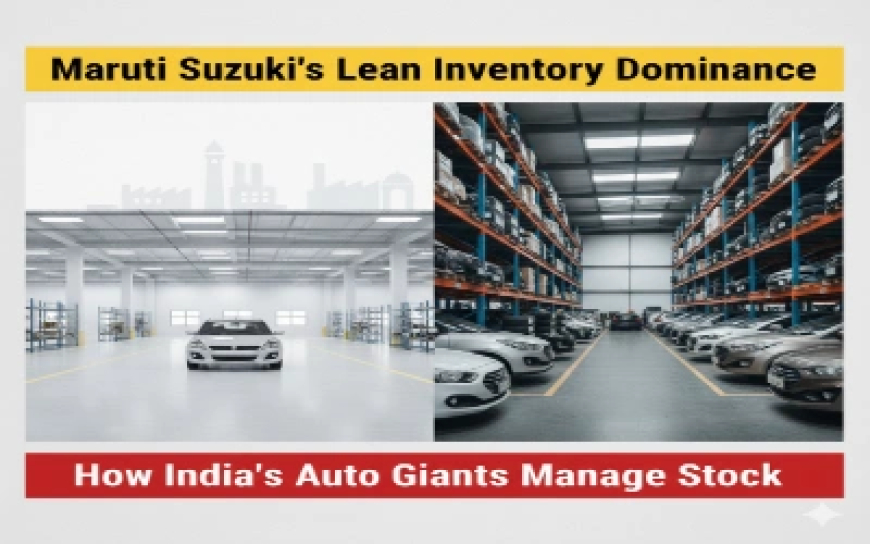Maruti Suzuki Inventory Management Outshines Rivals: A Deep Dive into Lean Operations
Discover why Maruti Suzuki's inventory levels are significantly lower than Tata Motors and Mahindra. This analysis explores efficient supply chains, rapid turnover, and strategic focus, providing insights into India's auto industry.

By: Dainik Realty DESK | Date: 13/Sep/2025
Indian Auto Giants: Unpacking Maruti Suzuki's Lean Inventory Advantage
India’s dynamic automobile sector is witnessing a distinct divergence in inventory management strategies among its leading players. As of March 2025, Maruti Suzuki stands out with significantly leaner inventory levels when compared to industry peers like Tata Motors and Mahindra & Mahindra. This contrast is not merely a statistical anomaly but a reflection of fundamental differences in product focus, deep supply chain integration, and a highly efficient sales ecosystem that allows Maruti to move vehicles rapidly from production lines to customers. The implications of these disparate approaches extend beyond operational efficiency, influencing market responsiveness, capital utilization, and ultimately, the competitive landscape of the Indian automotive industry.
This notable gap in stock holdings underlines a strategic operational advantage for Maruti Suzuki, enabling it to minimize holding costs and react more nimbly to market demand fluctuations. While higher inventory might offer a buffer against supply chain disruptions or sudden surges in demand, it also ties up significant capital and incurs storage expenses. Understanding the intricate factors behind Maruti’s lean model versus the larger inventory buffers maintained by Tata Motors and Mahindra offers critical insights into the competitive dynamics and operational philosophies shaping India's vibrant automotive market, making it a crucial topic for investors and industry observers alike.
Context & Background
As of March 2025, the figures reveal a striking disparity in inventory values across the top Indian automakers. Maruti Suzuki reported inventories totaling Rs. 6,913 crore. In stark contrast, Mahindra & Mahindra held inventories valued at Rs. 20,331 crore, while Tata Motors' stock soared to Rs. 47,269 crore. This substantial difference is primarily attributable to Maruti’s superior inventory turnover ratio, which stood at an impressive 17.75, indicating it sells and replenishes its stock nearly 18 times annually. Comparatively, Mahindra’s turnover ratio was 4.96, and Tata Motors' was 5.77, highlighting their slower stock movement. Further emphasizing this efficiency, Maruti holds inventory for an average of just 23.47 days before conversion into sales, significantly less than Mahindra's 77.51 days and Tata Motors' 63.48 days.
Why it matters
This disparity in inventory management has profound implications for each company’s operational efficiency and financial health. Maruti Suzuki’s high turnover and minimal inventory days signify its ability to rapidly convert stock into sales, optimizing cash flow and reducing capital tied up in unsold vehicles. Although Maruti Suzuki's inventories increased by 30 percent from Rs. 5,318 crore in FY24 to Rs. 6,913 crore in FY25, outpacing its sales growth of 7.8 percent (from Rs. 1,41,858 crore to Rs. 1,52,913 crore), its absolute stock levels remain significantly lower than its competitors due to inherent operational efficiencies. This lean model allows Maruti to be more agile in responding to market shifts and less susceptible to the financial burdens associated with carrying excessive stock. In contrast, the higher inventory buffers maintained by Mahindra & Mahindra and Tata Motors suggest longer supply chains, more diversified product portfolios, and a relatively slower movement of stock throughout their expansive networks.
Impact & Effect
Several structural factors underpin Maruti Suzuki's capacity to operate with such lean inventories. Unlike its peers, Maruti focuses predominantly on mass-market passenger vehicles, often standardized models. This specialization allows for highly predictable production cycles and streamlined stock management across its operations. Furthermore, Maruti boasts an extensive dealer and distribution network that ensures the swift movement of vehicles from manufacturing facilities directly to customers, significantly mitigating inventory buildup at various points in the supply chain. Its strong integration with suppliers and established long-term procurement relationships further contribute to shorter replenishment cycles and reduced raw material stock, creating a virtuous cycle of efficiency.
Corporate Approaches & Strategies
The contrasting inventory strategies between Maruti Suzuki and its competitors, Mahindra and Tata Motors, are rooted in their respective corporate approaches and market segment focus. Maruti's strategy is built on volume, standardization, and a clear focus on the mass-market passenger vehicle segment. This allows for optimized production flows and a highly efficient just-in-time inventory system. Conversely, Mahindra & Mahindra and Tata Motors operate across multiple segments, including SUVs, commercial vehicles, and electric vehicles. These diverse product categories inherently require more complex components and more intricate supply chains, inevitably leading to larger inventory holdings. Their diversified product lines also introduce greater variability in demand, necessitating higher buffer stock to ensure supply stability across various segments compared to Maruti’s more homogeneous and standardized lineup. Also Read: [Future of Indian Automotive Supply Chains]
Expert/Local Analysis
Analysis of the Indian automotive landscape consistently points to Maruti Suzuki’s superior supply chain efficiency as the bedrock of its lean inventory model. This efficiency is directly linked to its concentrated focus on mass-market passenger vehicles, which allows for greater standardization and economies of scale. For instance, while Mahindra & Mahindra saw sales grow 14.5 percent from Rs. 1,39,078 crore in FY24 to Rs. 1,59,211 crore in FY25, with inventories climbing 9.4 percent, Tata Motors' sales grew only marginally by 1.3 percent from Rs. 4,34,016 crore to Rs. 4,39,695 crore, and its inventories actually declined by 1.1 percent from Rs. 47,788 crore to Rs. 47,269 crore. This illustrates how each company navigates its unique market challenges and operational complexities. Mahindra and Tata Motors, by embracing broader portfolios that include SUVs, EVs, and commercial vehicles, accept the necessity of carrying larger stock to manage the inherent complexity and ensure consistent supply stability across their diverse market segments. Also Read: [Stock Market Insights for Auto Manufacturers]
Conclusion
In summary, Maruti Suzuki’s significantly leaner inventories, marked by faster turnover ratios and shorter inventory days, are a testament to its highly efficient supply chain and strategic focus on mass-market passenger vehicles. This specialized approach enables predictable production and rapid distribution. In contrast, Tata Motors and Mahindra & Mahindra, with their extensive and broader portfolios encompassing SUVs, commercial vehicles, and electric vehicles, necessitate larger stock holdings to manage the inherent complexities of diversified product lines and varied demand. These differing inventory strategies highlight the unique operational challenges and competitive advantages within India's bustling automotive industry, with each manufacturer optimizing its approach based on its core business model and market segments. The ongoing evolution of this sector will likely continue to showcase these distinct inventory philosophies.





































